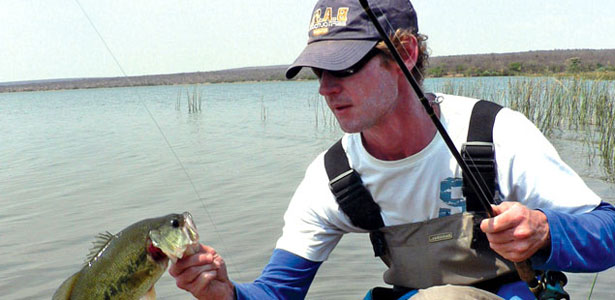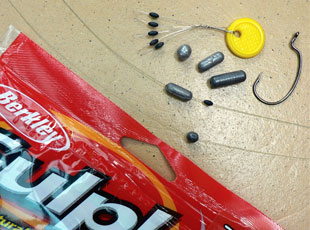
The “mini” Carolina rig, more commonly known as the Finesse, Mojo or Split-Shot rig, is an extremely effective technique at any time of the year and especially during cold, ultra clear or tough conditions. Generally, although not entirely the same as the Carolina, they all essentially are designed to do the same thing, namely provide bass with a slow moving natural presentation that’s hard to resist.
This is a simple rig that basically consists of a hook at the end of the line and a small weight set at an intended distance above the hook. In some conditions no weight at all is often ideal for a very slow fall or when fishing the bait ‘floating worm’ style just below the surface. Although this finesse rig can be fished at a desired speed, the whole idea when adding a Mojo or Split-Shot weight is to allow the bait to slowly sink to the bottom and retrieved as slow as possible to entice a bite.
There is certainly no hard and fast rule about how to fish this finesse rig and only the bass is going to tell you what will work on any given day. However this is a rig that will catch bass as effectively as the Carolina rig, especially in shallower water down to about 12-15 feet. Although the Carolina can also be fished at any depth it is best suited for probing deeper water structure with minimal cover using heavier weights.
The traditional Mojo or Finesse rig, because of the small weight, allows the angler to probe heavier cover situations and consists of a split shot crimped onto the line above the hook that allows the bait to slowly sink and stay below the surface. The problem with the split shot however is that there is always the danger of damaging the line when crimping the weight. This gave rise to the more popular Mojo weight, which is cylindrical in shape and moves through and over cover easily. It is attached to the line by pegging it with some rubber strands. For general purpose finesse fishing however a small rubber stopper can be fed onto the line below the weight, which allows for a free running sinker adjustable to any length. I prefer the free running mojo as the bass doesn’t feel any resistance on the bite and tends to hold on longer while swimming away with the bait.
One of the things I love about the Finesse rig or Mojo is the fact that in some situations you can slide the stopper down to the head of the bait and turn the whole rig into a mini Texas for pitching and flipping around heavier cover if necessary and still maintain a good, slow falling finesse presentation. Better still you can even add a plastic frog for example and fish the whole rig on the surface. The important thing to remember with the ‘mini Carolina’ is the size of the weight and the distance it is placed from the hook. The size of the weight used will determine the fall rate, fishing depth, bait size and give you more control in windy conditions.
A good rule of the thumb is to use the smallest weight you can get away with depending on the conditions for the most natural presentation. I generally try and match the Mojo weight to that of my bait and hook where possible to allow the whole rig to fall horizontally to the bottom as opposed to the weight pulling the bait down vertically. As mentioned before however, there are times where you will need to add a heavier weight, such as in windy conditions for example, or deeper water when you need to get the bait down quickly. The distance you place your weight above the hook can affect the speed at which your bait moves, on the fall as well as on the retrieve. Generally 1-2 feet is the norm but bear in mind that the longer the leader the slower and more naturally the bait will move, and the closer the bait is to the weight the more direct the contact and the faster it moves. In warmer water when bass are more active for example, a shorter leader can be used and likewise a longer one for more lethargic bass. This is not a hard and fast rule however and you need to experiment a little to see what the bass wants, or in situations such as fishing submerged grass you might want a longer leader to keep the bait on top.
If you need or like to use a Split-Shot as the weight there is a small procedure you can use to help prevent any suspected damage to your line. Crimp the shot gently at first and then wet the line and slide the shot up and down until it moves easily. Then crimp it some more if necessary until the point that you know it shouldn’t come off. Wet the line again and slide the shot up and down until it feels snug but moves fairly easily on the line. Then move it carefully up to a fresh section of line, cut off the section where you performed the procedure and tie on your hook. By doing this the line will have created a groove for itself in the lead shot and you can feel safe that there is no line damage as there might have been had you simply just crimped it on. As this is a finesse technique Split-Shot and mojo rigs are usually used on down scaled gear and lighter line in the 6-10 pound class, but is just as effective as a power presentation around heavier cover or murkier water with heavier rods and line in the 12-15 pound range. However in most finesse situations, whether you are spinning or baitcasting, use a quality, sensitive 6’6” to 7 foot rod in the medium action range for making long casts with light baits and which enable you to feel every movement. More importantly is to match your tackle and bait accordingly to allow for a natural slow presentation. Using a small finesse worm for example on a larger hook with a heavy rod and heavy line will deplete the action of the bait, so match up your gear and rig for an attractive presentation.
 What I love about the Mojo rig is that it is a great technique to fall back on in a lot of situations and especially when trying to establish what the bass want. Once you have covered an area with faster moving reaction baits for some active fish, the mojo rig will confidently pick up the less active fish and often the bigger ones. The slow “do nothing” fall of the bait followed by a slow retrieve along the bottom is often too much for even an inactive bass to handle. How fast you retrieve the bait is something you need to find but more often than not it is a very slow pull and pause type retrieve that works. Move the bait slowly with the rod not the reel and watch your line and rod tip for that flick, tap or movement that usually comes when the bait is paused. The bait can be slowly dragged along the bottom or even gently raised and allowed to fall again, however use this rig to feel your way along and if you feel your weight come up against some cover, shake the rod tip a little or gently pop it off and pause. Bass will often hit the bait when it does something a little different but more importantly fish slow and when you think that you are fishing slow...slow down some more!
What I love about the Mojo rig is that it is a great technique to fall back on in a lot of situations and especially when trying to establish what the bass want. Once you have covered an area with faster moving reaction baits for some active fish, the mojo rig will confidently pick up the less active fish and often the bigger ones. The slow “do nothing” fall of the bait followed by a slow retrieve along the bottom is often too much for even an inactive bass to handle. How fast you retrieve the bait is something you need to find but more often than not it is a very slow pull and pause type retrieve that works. Move the bait slowly with the rod not the reel and watch your line and rod tip for that flick, tap or movement that usually comes when the bait is paused. The bait can be slowly dragged along the bottom or even gently raised and allowed to fall again, however use this rig to feel your way along and if you feel your weight come up against some cover, shake the rod tip a little or gently pop it off and pause. Bass will often hit the bait when it does something a little different but more importantly fish slow and when you think that you are fishing slow...slow down some more!
This Finesse rig is designed to be attractive to the bass, is a very natural presentation and something which gives bass the opportunity for an easy meal with very little suspicion. Bass often just simply inhale the bait and move off, so give him a second or two and set the hook.
Practically any soft plastic bait can be used with the mini Carolina but being a finesse technique it’s usually the smaller ones. Some of my favourites are the straight tail worms such as the Gulp Floating Nightcrawler and Floating Worm series which tend to be more buoyant, stay up off the bottom more and I feel makes them more attractive and visible to the bass. However, small creature baits, Stickbaits or soft Jerkbaits work as effectively. If you like rig your bait with a slight up-turned nose which gives it a slight upward movement on the retrieve.
All said this is a technique which catches bass when others won’t and something which I always have ready to fish especially during the colder months or when Bass don’t want to play. It’s a very versatile rig which can be fished as a search bait like a Carolina, as a finesse Texas rig or... anything in between. Good Bassing!


 Visit us our
Visit us our